Prospect Park: Water Wars at LeFrak Center

(Aysha Choudhary/The Brooklyn Ink)
Two sisters, thick as thieves, draw water into their buckets and wait in the August heat, at LeFrak Center at Lakeside, to ambush passersby. The older girl tries her best to scoop the shallow puddle into a plastic cup. The younger, a bit more savvy, siphons it through her water gun. They spend long minutes filling these tiny vessels. But finally, when they launched their attacks, they fail to drench their victims completely. They can’t seem to reach above anyone’s knees.
In the Splash Pad, everything seems to be fair game. Kids pull parents into the frenzy of sloshing, their smiles gleeful as they cup water into their hands and spatter the faces of mom and dad. Toddlers press their backs to high-pressure sprinklers, smiling at the unusual sensation. Water guns lay in heaps, waiting to be put to use by future adversaries, though when the battles are settled, new friendships seemed to form.
— Aysha Choudhary
Park Slope: Summer School is over. Let’s dance!
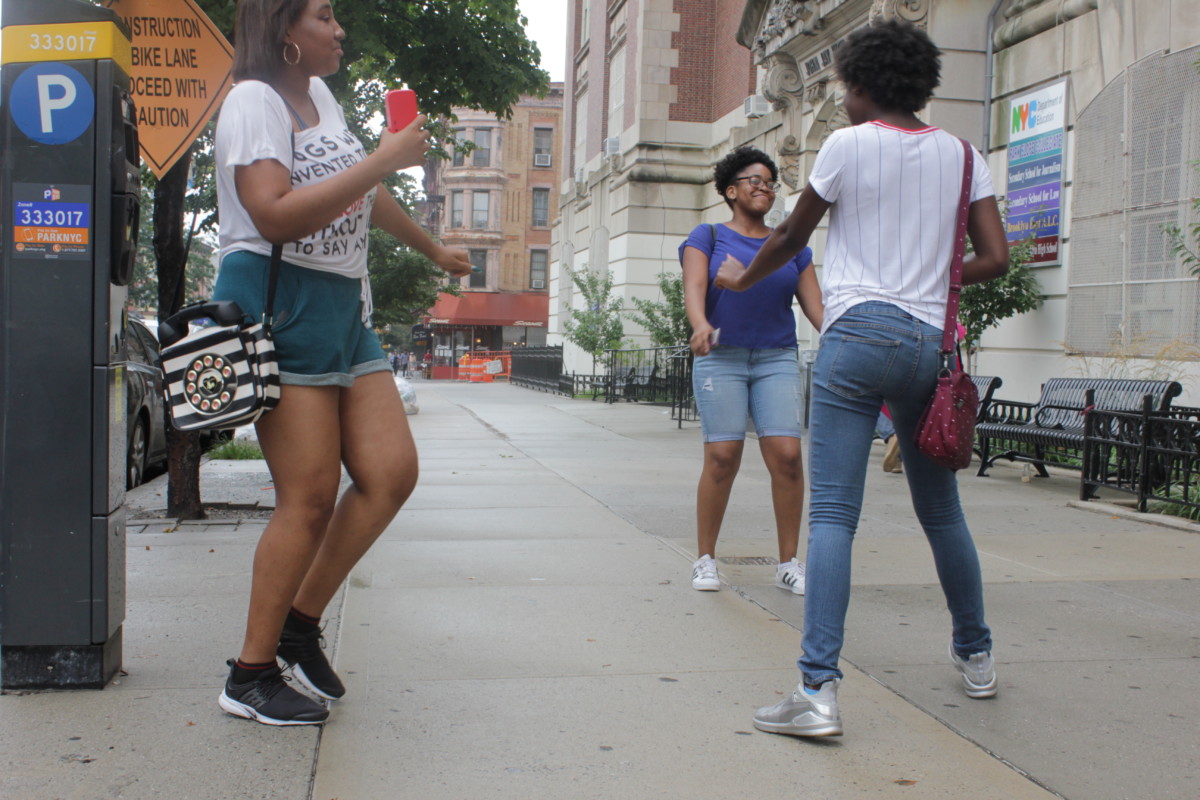
The pouring rain had just stopped on Seventh Avenue in Park Slope. Between Fourth and Fifth Street, loud music began to play. Three girls were jamming to the sound right on the sidewalk, outside the massive John Jay Educational Campus, an odd place to see teenagers having fun. The hot and humid air was keeping most people inside, but not these girls.
Megan Richards held her red IPhone in the air for everyone to hear “Bodak Yellow,” by Cardi B., play loudly from the speaker. At first, her two friends, Treasure and Terriann, seemed hesitant, but all it took was the right song for them to start moving their arms and shoulders to the beat. And as these 17-year-olds danced they sang along to the rapper’s song, unapologetically screaming out the swear words.
To most people, this was probably an ordinary, rainy Tuesday, but Megan, Treasure, and Terriann had just completed their mandatory summer school classes. They will officially move onto the 10th grade in the fall. They danced openly and proudly in front of the school that had kept them imprisoned all summer.
— Pepper Baker
Sunset Park: Everybody Into the Pool
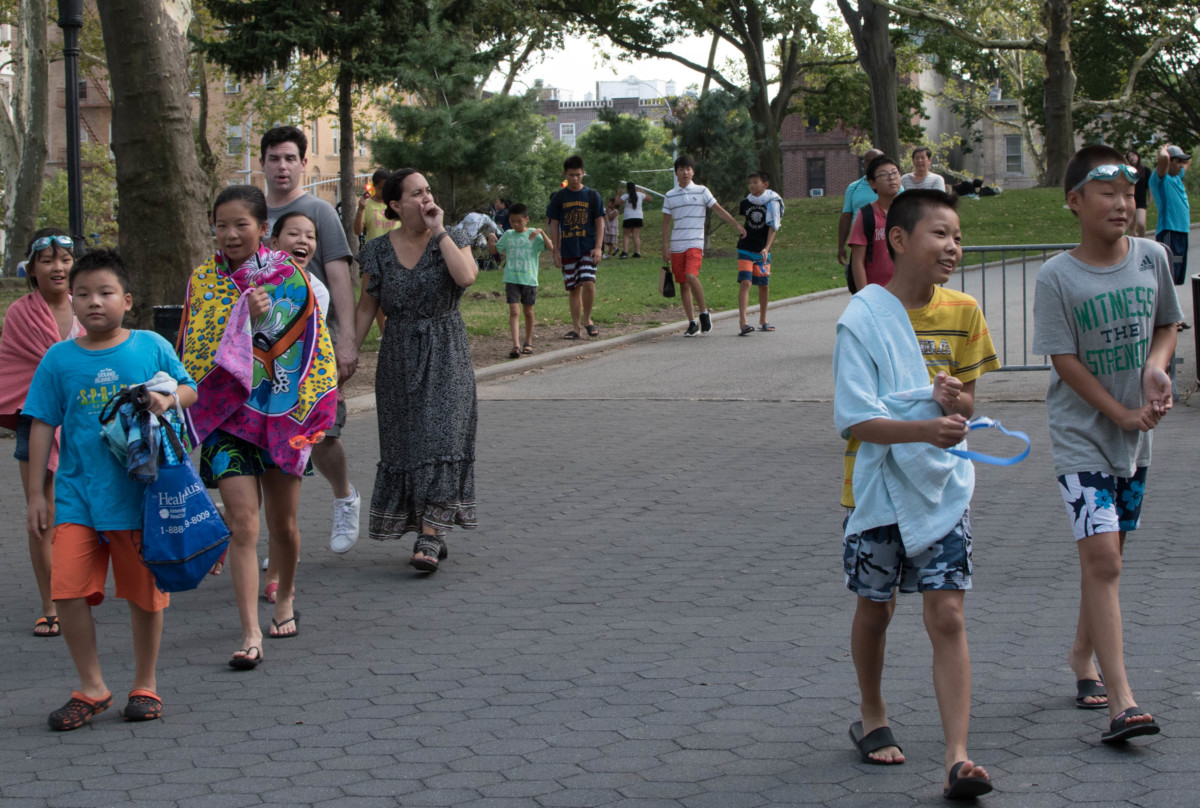
(Lynn Fantom/The Brooklyn Ink)
The rule is explicit: only white shirts are allowed on the pool deck and in the water. It is a NYC Parks regulation resulting from a 1989 gang shooting that killed a 13-year-old girl at a Harlem pool. That’s not the only rule. No newspapers or electronics are allowed.
Still, on this sunny afternoon, as another summer starts its final chapter, New Yorkers are willing to separate from their iPhones for a dip in Sunset Park’s free pool. They head towards toward the Art Moderne bathhouse with the determination of commuters striding toward Penn Station. Patiently lining up around the guardrails, they wait for security guards, as serious as airport personnel, to check their bags. Some open shopping bags to present recent purchases, a white T-shirt or mesh-lined swim trunks, still tagged.
Opened in 1936 along with ten others around the city, Sunset Park’s Olympic-size, outdoor pool was a project spearheaded by the legendary Major Fiorello LaGuardia and his Parks Commissioner, Robert Moses, and partially funded by the Works Progress Administration (WPA). According to Alexa Alazzan, 38, the NYC Parks supervisor in Sunset Park, on a good day the pool attracts 1,500 people, which is “really nice.” In Sunset Park, the Hispanics tend to play dominoes and the Chinese seem to love ping pong, but everyone goes to the pool
Inside the pool area, after a pre-swim shower, a pre-teen Latina flaunts her turquoise and coral bikini, ruffles on both the top and bottom. In the pool three children cling to their father as if he were a coat rack. The universal chant of kids yelling “Ma! Ma!” surfaces above the staccato whistles of the six orange-clad lifeguards on their poolside perches. For one couple, the temptation to splash each other just can’t be resisted.
The pool’s christened name, after all, is Sunset Park Play Center.
— Lynn Fantom
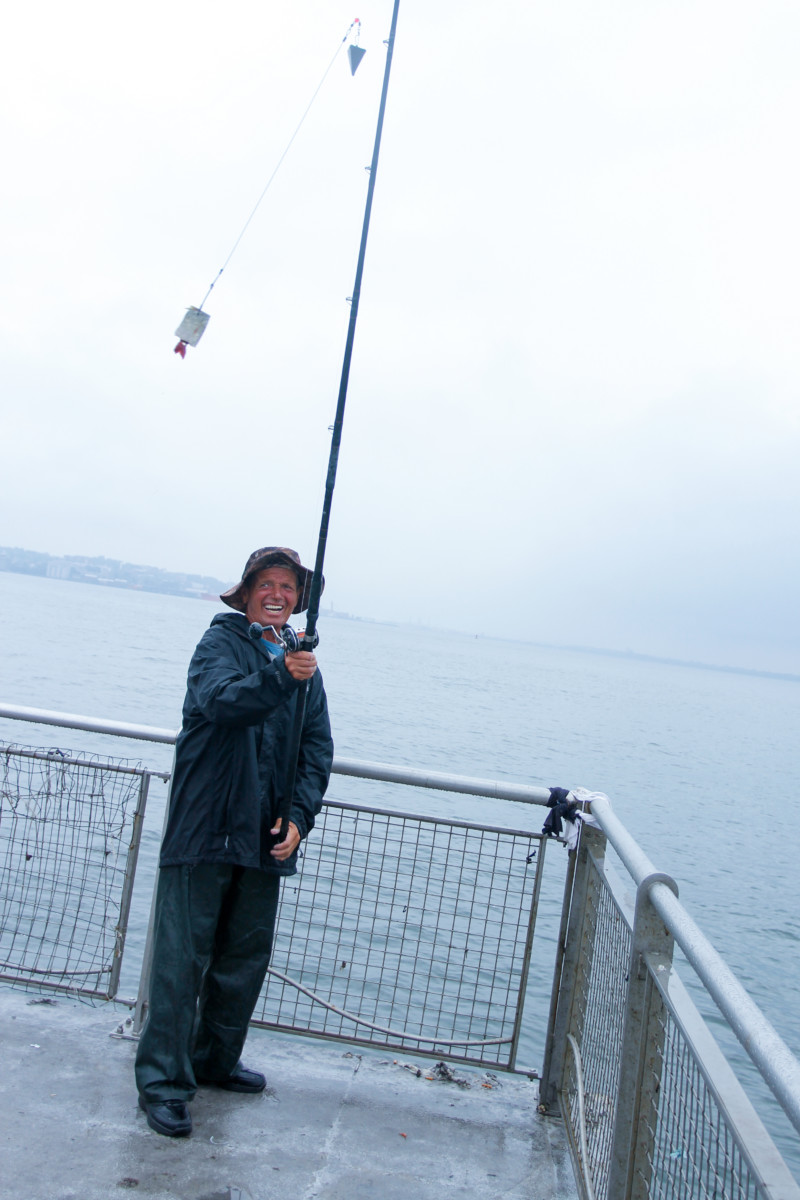
Bay Ridge: Rainy-Day Fishing
The crowded 69th Street Pier is a summer staple in Bay Ridge. Warm days see fishers lining the waterside, couples and families relaxing on the scattered benches, and aspiring photographers snapping the panoramic Manhattan skyline. But on Aug. 15th, this cement outcrop instead personified the dwindling sunny season. Heavy rain scared off most people—except for one lone angler casting for striped bass.
George Denoto’s two rods hung, lines taut, from the far edge of the pier. A few feet back, his beach umbrella and folding stool sat in front of a silver scooter. He waited for fish from this protected perch. But today, he explained, the lines’ movement mostly signaled bait-thieving crabs.
“I’m not a fish eater,” Denoto said of his pursuit. “But I can give ’em away, or sell ’em.”
A small American flag sticker between the scooter’s handlebars mirrored a larger version nearby, which hung limp in the wet air. The prized fishing wharf is also known as American Veterans Memorial Pier; besides a flagpole, it boasts a monument to those who died on Sept. 11, 2001, and a view of the Statue of Liberty.
The fisherman’s dedication was evident from his well-worn gear and crisp end-of-summer skin. Occasionally, he stood to replace stolen bait and re-cast a line, carefully hooking small pieces of fish that he had chopped on a board nearby. Then he returned to his perch to sit in silence, hands grasping his crossed legs, gaze fixed on the water.
As the rain let up, a couple of Denoto’s buddies wandered out to the pierhead. They chatted history: The wharf’s surface used to be made of wood, one said, and before the Verrazano Bridge opened in 1964, its bygone ferry service was the only way to reach Staten Island. This June, 53 years after the old ferry stopped, a new South Brooklyn line began to ship commuters from the pier to their Wall Street mornings.
Though they talked occasionally, the men mostly stood in silence. All three said they loved the pier, and were braving foul weather to steal these moments of calm. But the role of rainy day fisherman was reserved for Denoto.
“I’m the only crazy one,” he said, line empty but his grin still full.
— Rebekah F. Ward
Coney Island: Castles and Dragons in the Sand
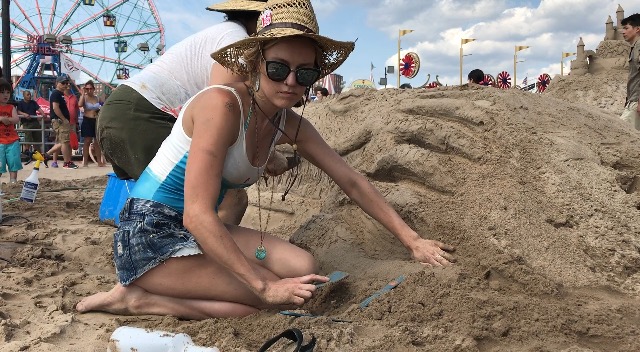
(Caitlin Foster/The Brooklyn Ink)
Every year on Coney Island, beachgoers flock to witness the celebrated August sand castle contest, to witness mounds of sand being transformed into pieces of art. The four-hour event takes place mid-day, and as the competition gets underway, spectators who first weaved through shapeless piles of sand eventually make their way past miniature dragons, a seaweed-wrapped lizard, mermaids, boats, and yes, even some castles.
To the spectators, the transformation is nothing short of magic. But the contest is more like a marathon to the competitors, who pour their sweat—and sometimes their tears—into their work. When the bullhorn sounds, teams begin the first step. Whatever their method, they make their sand damp in order to shape it. Melissa Farrar and her team shovel sand into a black trash can, then use a hose to wet it before dumping it back out and starting the real work.
Some competitors seem to learn the meaning of teamwork as they cope with the heat and the looming possibility of catastrophe, and Farrar and her team have one such story. They persevere despite the collapse of their dragon in the third hour of the competition. Their design is split almost exactly in half, with the collapsed side looking like the sheer face of a mountain.
And in the end, that’s exactly what the team chooses to make of it. The team transforms their sand yet again. In only one hour, they create a winding path up the sheer face of a mountain, ending at a doorway leading into the belly of the dragon.
Melissa and her teammate Kate use knives and trowels, a vibrant feather duster, and a trusty spray bottle to put the finishing touches on their dragon. Even the winding mountain pathway is given shimmering scales. Farrar uses gold and multi-colored glitter to create the illusion that makes their creation come to life.
—Caitlin Foster
Brooklyn Heights: Tiny Twins at the “Beach”

Amid the chatter and laughter of the people at the barbeques nearby, and the boisterous blend of rap and Hispanic music, a small section under Brooklyn Bridge’s Pier 4 seems like another world. There are no grills here. No speakers blasting tunes. There is sand. And a grey stream from the East River that poses as a beach. But to Lotus and Phoenix, two-year-old fraternal twins, Pier 4 is paradise on a Sunday afternoon.
“Come on, stop, we’re about to leave,” Starlyn Wins, the twins’ mom, said to her daughters.
No response. Phoenix, in her navy blue shirt and denim skirt, teeters towards a rock, picks it up, and corks her arm to launch it. But her mother reaches her in time and snatchs the rock from her hand, bringing Phoenix to tears.
“I’m going to put you in the stroller,” Wins says.
“No,” says Phoenix.
Meanwhile, Lotus wobbles towards the shore, unafraid of dirtying her pink shirt and white skirt. Like her sister, Lotus is intrigued by the idea of throwing rocks. Her mother has other plans. Her playful tone turns more serious, as she begs her daughters once again to stop picking up rocks.
For a minute, it seems as though the girls might obey. The twins attempt to build a sand castle, and Lotus got distracted, filling her green bucket to the top.
Phoenix is not satisfied, however. She gets up from the sand and asks her mom if she can throw the rock in the water. Wins takes a deep breath and says “Just don’t get your shoes wet.”
Phoenix runs toward the shore, surveys the available rocks, and picks one up. She looks back and says, “Mommy, look at me.”
— Daniel Ynfante
Crown Heights: A Summer Parting
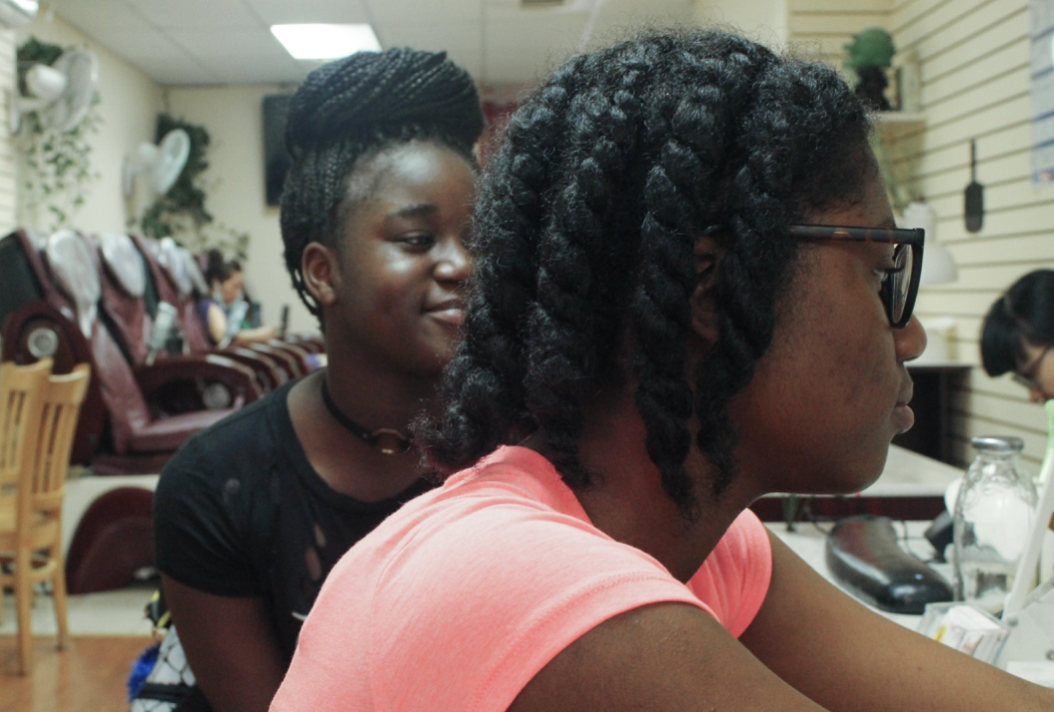
They giggle to themselves. Jade Barthwaite, 13, and Delicia Noel, 13, meander through the weave shop’s three aisles. Jade has long black braids and Delicia wears twists in her natural hair, shoulder length and loose. They stop to examine hair extensions, accessories, and hair treatments. Although there are hardly any other patrons, they stay close to each other, chatting and laughing quietly.
A middle-aged shopkeeper, an African migrant, overlooks their browsing. He is flanked by transparent plastic packets of human hair—long, glossy locks from across the globe; “Malaysia,” one label reads. Two employees stock shelves. The girls spend more than fifteen minutes inside before walking out onto Nostrand Avenue, where it is drizzling.
They pass hairdressers, shops, and restaurants catering to American and West Indian palates before eventually ducking into a brightly lit nail salon. A handful of Chinese nail technicians sit behind tables on either side of the room, waiting for clients. In the back left-hand corner of the salon, a row of maroon foot-spa chairs sit empty but for a beautician staring at her phone.
School starts in two days, and Delicia (the word means “delicacy” in Spanish) asks to get her clear acrylic nails touched up. She wants to look good for the beginning of 8th grade. The girls sit down and a manicurist starts filing Delicia’s nails. Jade watches.
Jade is a year behind Delicia and will be starting 7th grade in a different school. She is from Long Island, but has been able to stay with Delicia in Crown Heights for much of the summer. She is not looking forward to starting high school, she says, because of all “the drama.” Once school starts, the two friends won’t be able to spend as much time together. It is the end of summer.
— Maea Lenei Buhre
Red Hook: Inside the Yellow Food Truck

Standing next to his bright yellow food truck, Marcos Lainez chats in Spanish with a customer whose right arm is in a sling. Lainez is the owner of El Olomega, the business on wheels that serves Salvadorean cuisine—namely pupusas, a fried dough specialty with various fillings. As a line begins to form in front of the truck, Lainez glances over occasionally to ensure that his customers are walking away satisfied.
Five other food trucks line the corner of Bay and Clinton Streets, where a nearby soccer match provides the entertainment. The sun beats down and shady spots are at a premium. People line the black chain link fence around the field, standing in clusters to watch the men play, while five kids play a soccer game of their own in between the fence and one of the goal nets. The food trucks will serve these customers well into October, but business is expected to slow down as the end of summer approaches.
Inside the truck, an older woman takes orders from the window on the far right, simultaneously kneading a ball of pupusa dough with her hands. Next to her, another woman uses a spatula to flip the circular dough patties on the grill, removing them only when both sides have earned a light brown crisp. Next to her, a third woman drops a basket of raw plantain strips into the fryer before spinning around to take a customer’s cash.
— Jennifer Sigl
Cobble Hill: Here Comes Another High-Rise

It’s a wet day in late summer on Atlantic Avenue, and as you reach its western end, past the Mediterranean stores and old-timey Long Island Restaurant, a bleak scene awaits. The ground rumbles with the sound of workers in the final stages of demolishing the 156-year-old Long Island College Hospital, which closed its doors to patients two years ago after a long battle to keep it open. In its place, work on a luxury 28-story condo development called River Park will begin this fall.
The apartments will feature sweeping views over the East River—but will also throw part of Cobble Hill into shadow. John Ellis, a construction worker, was sitting in his truck at the side of the site. “It’s sad,” he said. “But people like to be with their own kind. Rich people like to live around other rich people. That’s the way America’s going these days.”
Up and down the pretty, brownstone-lined surrounding streets, ‘No Towers In Cobble Hill’ posters can be spied in every other window. At nearby Lina’s Barber Shop, Yeazid Farraj—a lifelong Brooklynite—is about to move to Staten Island so he can switch from paying rent to paying a mortgage. But he said he’ll still come to come to Lina’s to get his hair cut the way he likes it (he’s completely bald). He doesn’t like all the new developments. “It doesn’t stop. It just keeps going,” he says. “Next we’ll be seeing 40, 50 stories. It’s insane.”
Politico and The New York Post reported last year that none of the apartments in the new development will be priced at a lower-income bracket, following a dispute over the rezoning of the site. A little further along from the mass destruction, Jamaican-born Chris Barrett and his coworker wave their orange flags in a in a desultory way at the oncoming traffic, directing cars to slow down as they pass the site. Chris says doesn’t mind his job—he’s been at it five years—and he particularly enjoys it when it’s raining.
— Isobel Cockerell
Williamsburg: A Day made for Ice Cream
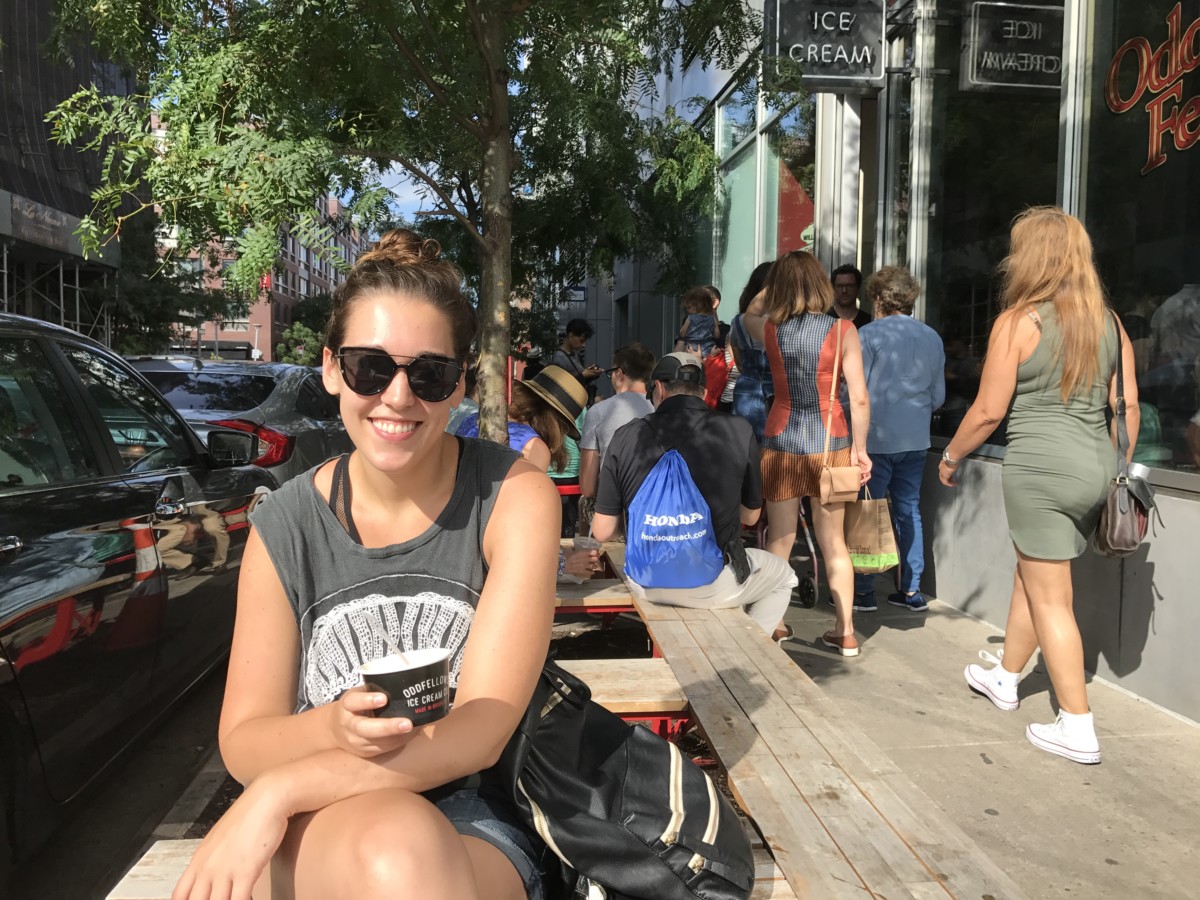
On a sunny Sunday in Williamsburg the jingle of a Mr. Softee truck played as people walked the streets. It was the kind of warm afternoon that called for cold treats. OddFellow’s Ice Cream Company, just blocks from the waterfront, was prepared.
Patrons sat on wooden benches outside the small establishment with milkshakes and dishes of ice cream. The customers looked satisfied.
Christina Wiedbusch, 25, was enjoying a cup of Thai iced tea-flavored ice cream with sprinkles. She had ventured to OddFellow’s after a failed attempt to get vegan ice cream at Van Leeuwen’s Artisan Ice Cream, just around the block. The line there was too long, she said.
Still, the line at OddFellow’s Ice Cream extended past the door and wrapped around the front window by the time she sat on a bench drenched in sunlight to dig into her quickly melting treat. At 80 degrees with 50 percent humidity, ice cream was not lasting long for anyone seated outside. As she scooped up the rapidly melting dessert, a droplet fell to Christina’s chin. She quickly cleaned it off.
— Morgan Hines
Fort Greene: The Soul Summit
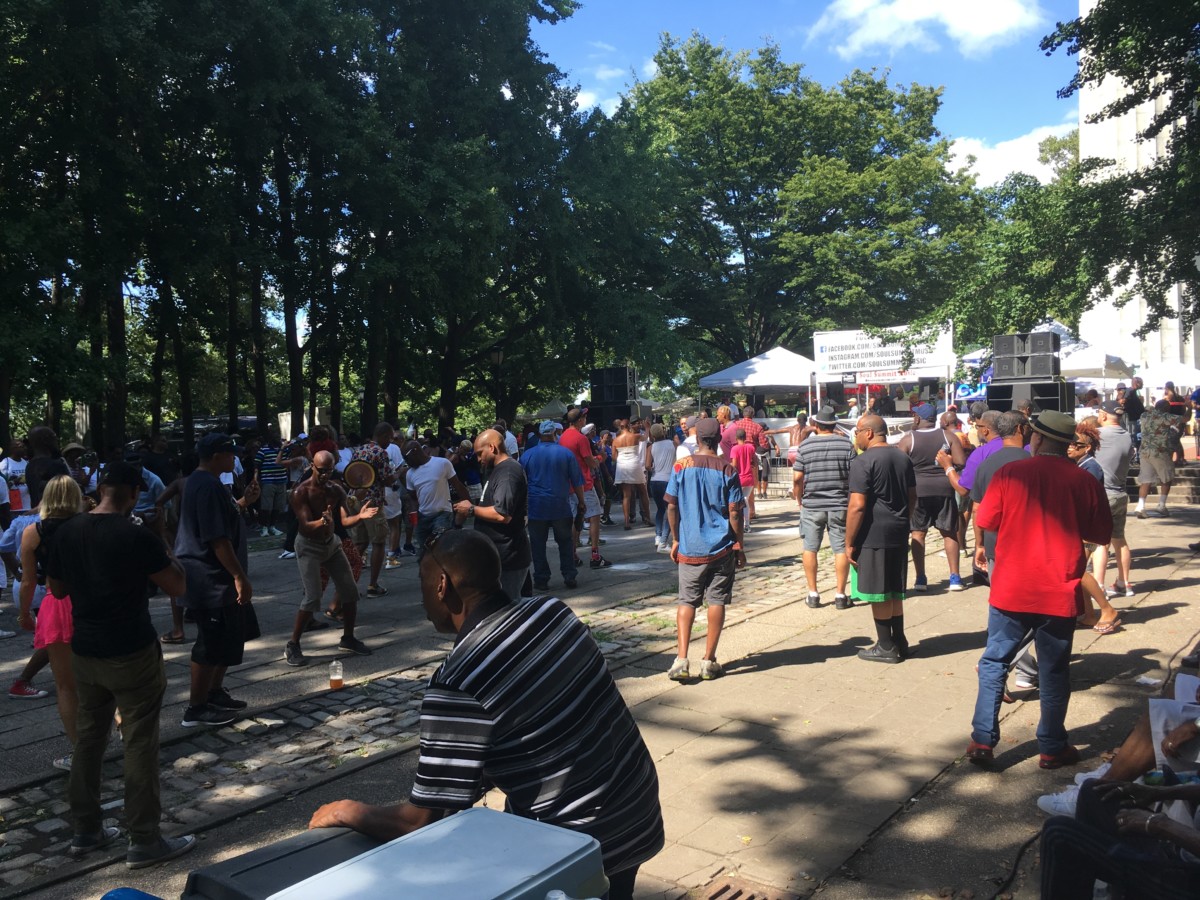
(Brian Pascus/The Brooklyn Ink)
The drumming can’t be heard at first, as you approach the Fort Greene Soul Summit Festival. Instead you hear a rising chorus, mingled with bouts of laughter and shrieks of joy. On this August Sunday, different strains of music, from the urgent beats of rap or the soulful grooves of funk, dive into your ears as you pass through bands of people sharing songs on Bluetooth speakers.
Their skin color is varied—dark, mocha, beige, tawny brown, and blacktop black. Two tiny toddlers chase after each other like cheetahs, while an aging grandmother is served a cold glass of juice by two women who look like her daughters. Over in the corner, a trio of teens is lighting something up, which may or may not be a tobacco cigarette. Soon come the smells— pungent scents of Creole cooking or old-fashioned backyard BBQ. Paprika, cayenne pepper, brown sugar, and Sweet Baby Rays are simmering over meats on the grill.
As you get closer to the music, you see the source of the drumming—a group of men, fit and lean, back to back, paddle their hands in a rhythmic motion, to and fro. The women before them, decked in rainbow dresses, their hair wrapped high in the Empire fashion, dance to these beats, spinning and losing themselves to the sounds.
— Brian Pascus
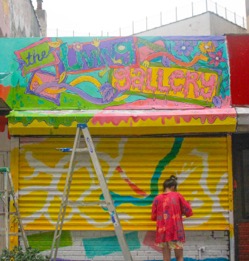
Bushwick: A Lively Painting for the Living Gallery
Lexy Ho-Tai of Bushwick is battling the rain on a Tuesday in August to paint a new façade on the exterior of the Living Gallery on Broadway in Bushwick, a community exhibit and event space, as well as a home for art classes. The gallery repaints the exterior of the gallery every two months, “so this will be the last one for the summer,” Ho-Tai said.
Paint brushes and paint canisters are sprawled all around her as she meticulously works to bring her vision to life. She climbs rain-covered ladders to reach the top of the building. Onlookers glance as Ho-Tai paints but continue on their way as the rain keeps coming down.
She wanted to do something colorful, and the colors splattered on the façade are just as bright and vivid as Ho-Tai’s loose red shirt. She paints silhouettes of long paint brushes sprawling across the garage-like canvas. The silhouettes seemed to move across the painting. “A lot of the people here really look forward to seeing what the new painting will be when we change it up,” Ho-Tai says.
— Marvin Richards Jr.
McCarren Park: A Noisy Game of Softball
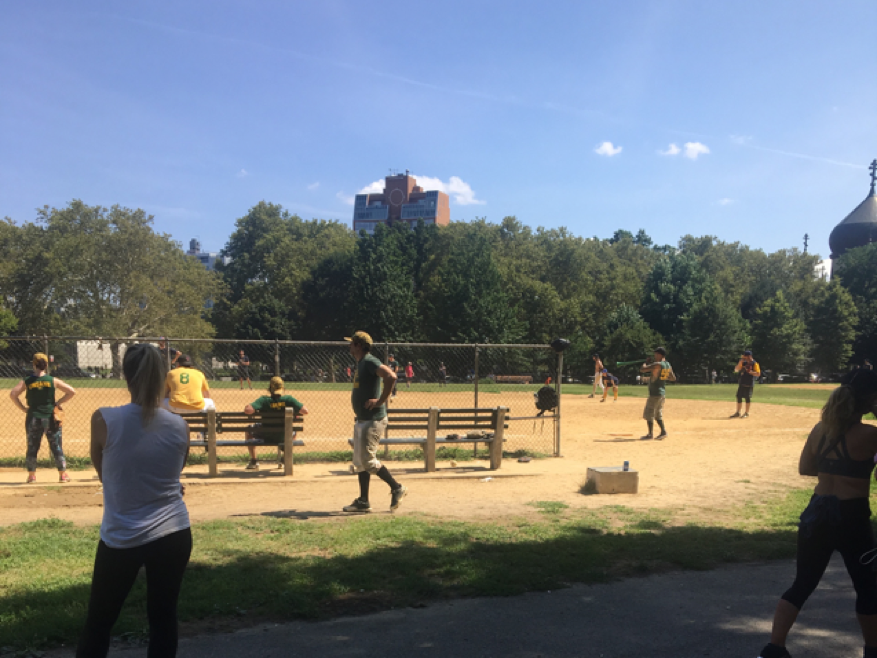
It’s a sunny yet windy August day and McCarren Park, which falls right between Williamsburg and Greenpoint, is buzzing. On the patchier, less popular side of the park’s giant lawn, a couple of softball fields face each other. There are two games going on simultaneously, and because of the size of the field the players in the outfield are intermingled.
One of the games clearly dominates the space—Saint Anselm versus the AT All Stars. Everyone in the surrounding area is oriented in their direction, often including the players in the other game. Saint Anselm wears blue and yellow, and the AT All Stars wear yellow and green, but the players aren’t dressed consistently. Some wear cut-off sleeves, some wear alternate colors, and some aren’t wearing a uniform at all.
When the AT All Stars come to bat, it becomes clear that they are the more rambunctious crew. One player yells, “That’s how you do it son!” when his teammate hits a home run. Another player, number 56, carries around a vuvuzela—one of those long, loud horns popular in soccer crowds—in one hand and a megaphone in the other, constantly broadcasting ole ole ole ole!
Friends and family sit nearby, watching, talking, and drinking beer. One group is chatting idly until their friend hits another home run. Then they erupt in cheers: “Way to go, Munch!”
Some of the players’ kids are there too, though they appear to be slightly bored. Player number 56 walks over to entertain them for a while. They try to snatch away his vuvuzela, but he won’t let them have it. Instead, he uses his loudspeaker to shoo them away. The kids later start play fighting, and an older kid admonishes his siblings: “No roughhousing unless you’re in the roughhouse!”
— Nafisa Eltahir
Bedford-Stuyvesant: A Sidewalk Crepe Party
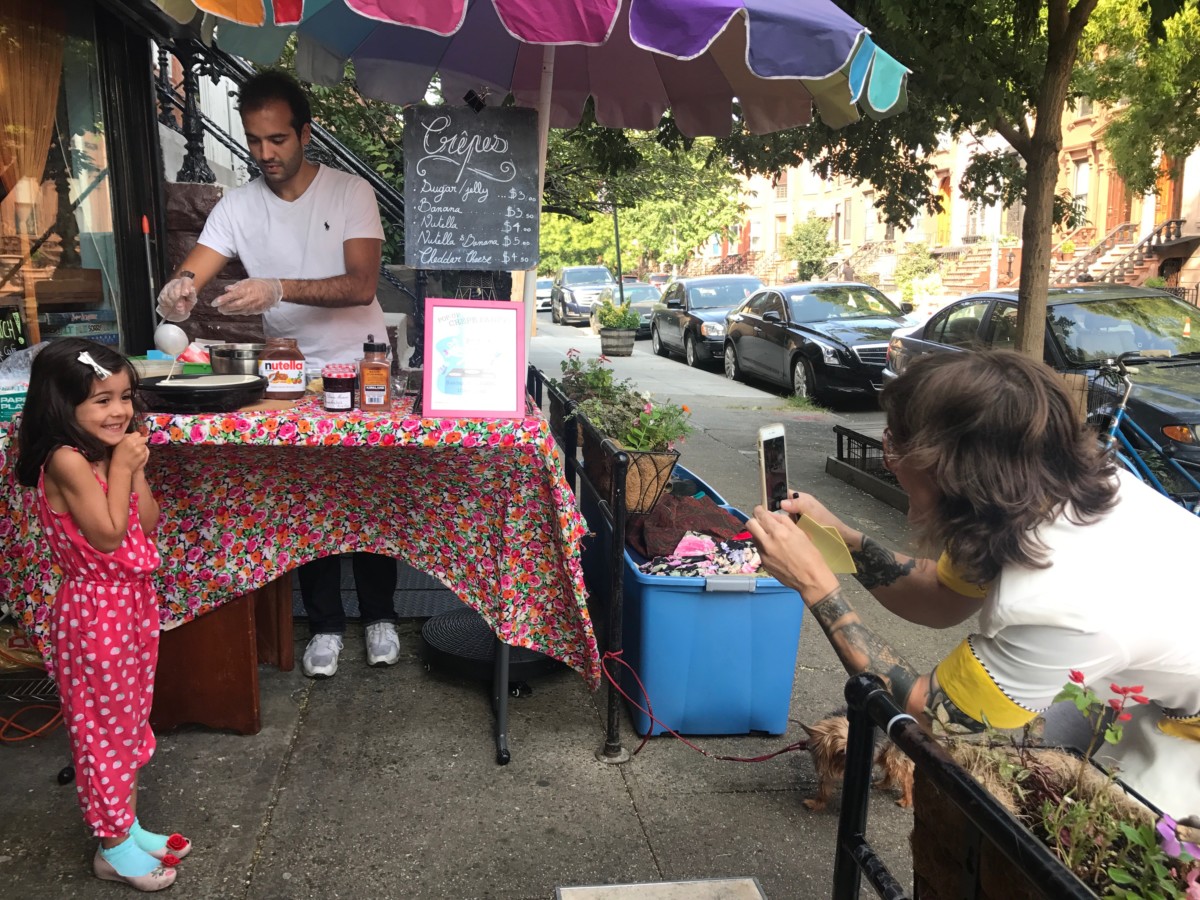
On a peaceful Sunday morning on Halsey Street right off Stuyvesant Avenue, chef Sofian, a young Frenchman, is making nutella crepes in front of Georges-André Vintage Café. The owner, Karine Petitnicolas, is taking a photo of her youngest customer, a little girl named Betsy. Karine’s dog, Wee-wee, looks impatient about Karine’s shifted attention. “Look more excited, Betsy!” Karine shouts.
She is an energetic woman, and she runs the show at her cafe. “I’m the one who serves you coffee. I’m the one who opens the coffee shop every day. I know my customers. They know me. They know my life. Their kids are around the same age as my own.” Betsy is about the same age as Karine’s son André, who’s four and a half. She is a regular. But today she is especially happy about the crepes.
The crepe party Georges-André is having is a collaboration between the two friends. Karine, who came to the U.S. as an au pair from France 22 years ago, met chef Sofian when she moved into Bed-Stuy from Queens in 2009. She hired him to move the furniture in her furniture store, which a year later became this coffee shop.
This summer, Sofian called Karine and said that he wanted to do an event with one of the local cafes. Karine said, “Let’s do it!” It was a big hit, she says. Then she called Sofian again and said at the end of summer they might not be too busy, so “let’s do it again.” Today is the last day of the crepe party, so Betsy was lucky.
— Momo Hu
Gowanus: Ice Cream Season, Winding Down
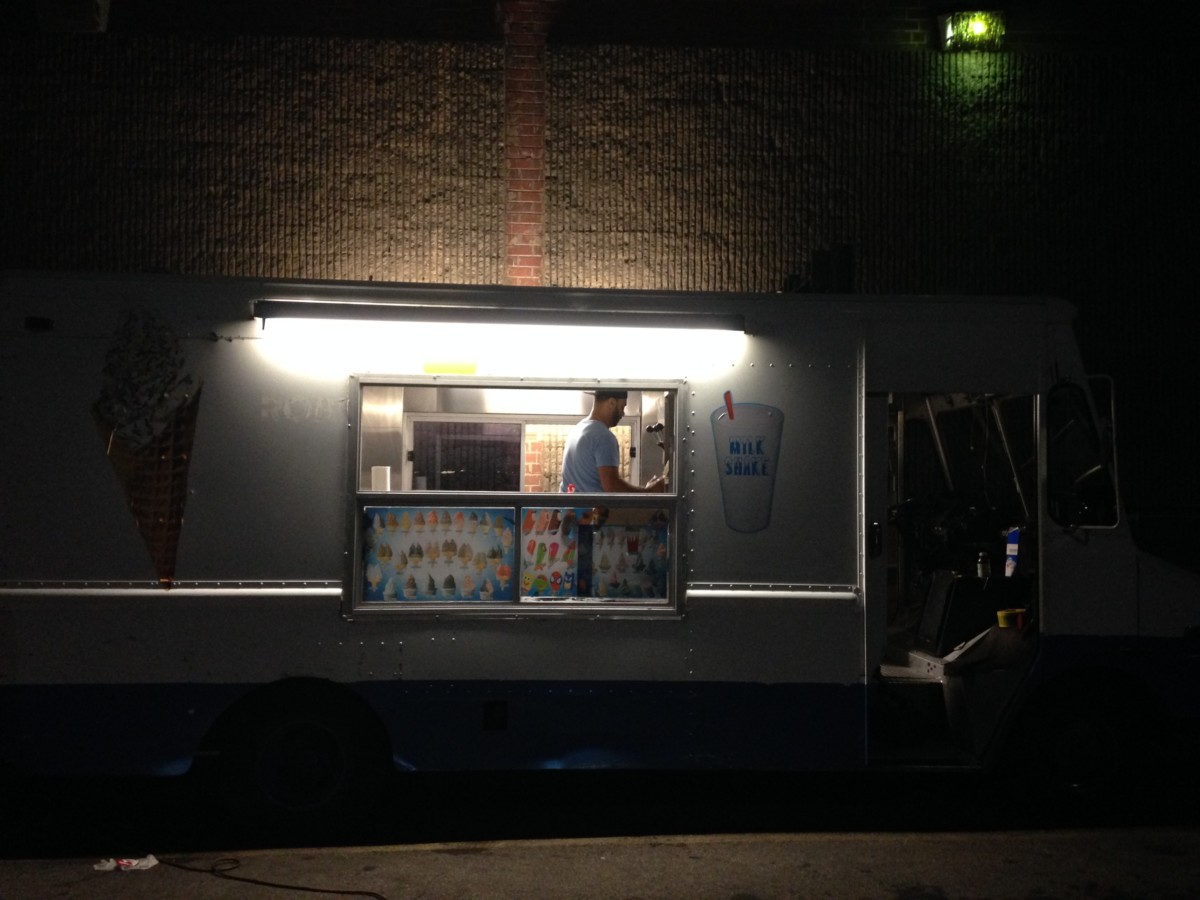
10:40 pm. A stray Halal cart pulls into the lot at the corner of Nevins and Union, towed by silver minivan. Through the open fence, past a “Private Property: No Trespassing” sign and a sleepy security guard in his tiny booth, the cart disappears around the back of a vast, windowless warehouse along the east side of the Gowanus Canal.
The lot is filled with a variety of food trucks, arrayed around the perimeter of the 25, 000-square-foot warehouse. Gary’s Steaks (Cheesesteaks and Hoagies), Carl’s Steaks (Proud Sponsor of the New York Yankees), Cachapas on Wheels (Con Sabor Venezolano), Toum (Authentic Lebanese Cuisine), Gorilla Cheese (347-67-GRILL), and on and on. Doors closed, engines off, all tucked in for the night.
The only light still on comes from a blue and white ice cream truck parked against the warehouse. Inside the truck’s long rectangular window, between the giant waffle cone and cartoon milkshake, Mike leans over the softserve handles, a baby blue t-shirt draped over his broad frame.
Finishing up the last tasks of his long day, Mike grabs a spray bottle and surveys his workstation for any stray drips or rainbow sprinkles. He wears a fitted cap turned backwards, a thin gold chain around his neck, and eyelids that seem to weigh his whole head down. Tall and beefy, with a close-cropped beard, he wipes down the counter and slides the window shut.
For most of Mike’s customers, now staring down the impending start of a new school year, ice cream season isn’t nearly long enough. But Mike, 33, is looking forward to the colder months. Mike’s dad, who has owned the truck for about ten years, also has a construction business, and Mike helps out there sometimes, but mostly he enjoys not being in the truck.
“We close up in October,” he says, and explains that the truck remains idle all winter. “It just stays parked,” he says. And Mike? “I do nothing. I stay home.” For now, though, he has more ice cream to sell.
On the front of the truck, under the window, a large graphic advertises the cones; double cones; sundaes; milk shakes; and the Spiderman, Spongebob and Teenage Mutant Ninja Turtle bars Mike will be hawking again tomorrow.
“I like it. It’s fun,” Mike says about his job. The only thing he minds is the jingle. Repetitive and singsong, it’s just not Mike’s style. “It bothers me,” he says. If he had his way, Mike says, “I would change it.” He thinks for a second and adds: “To music.” Another pause. “House music.”
— Joe Dobkin

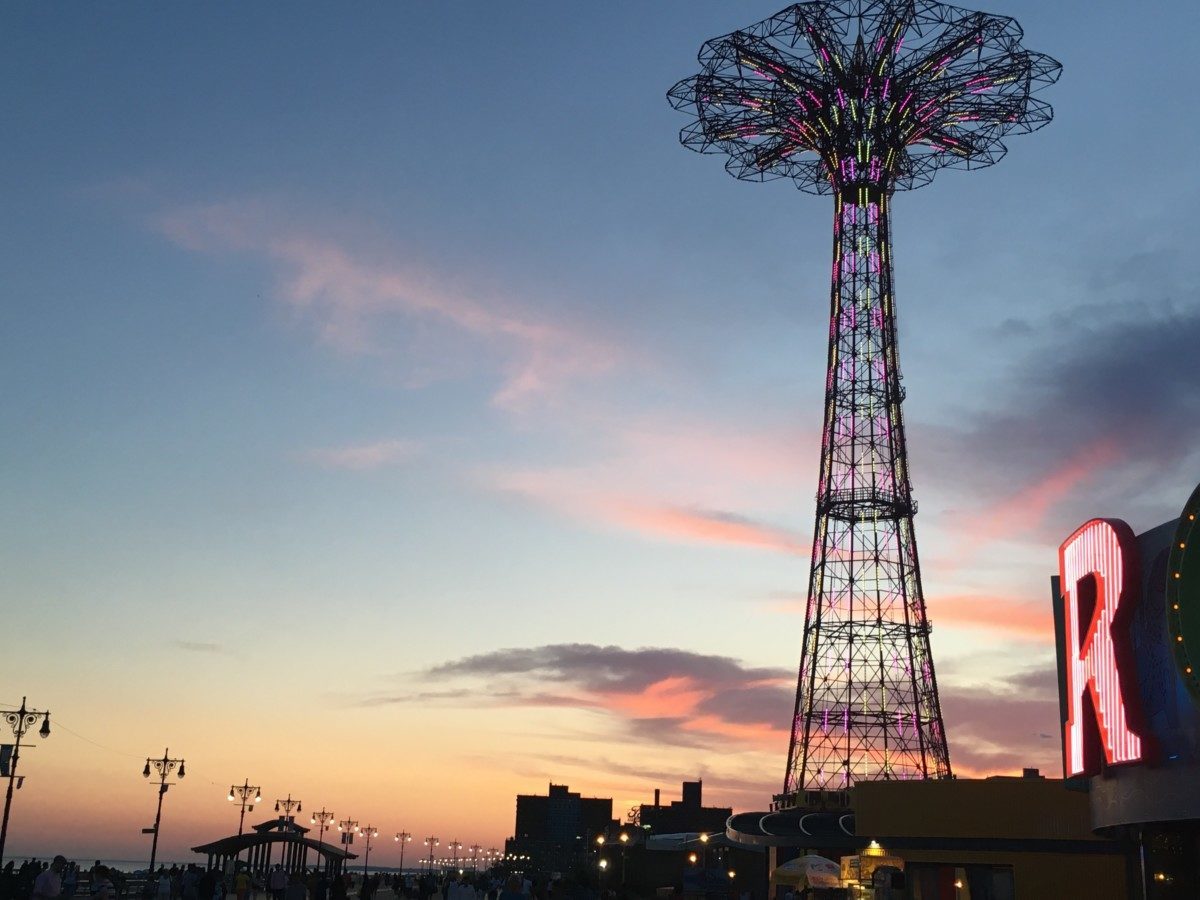
Leave a Reply